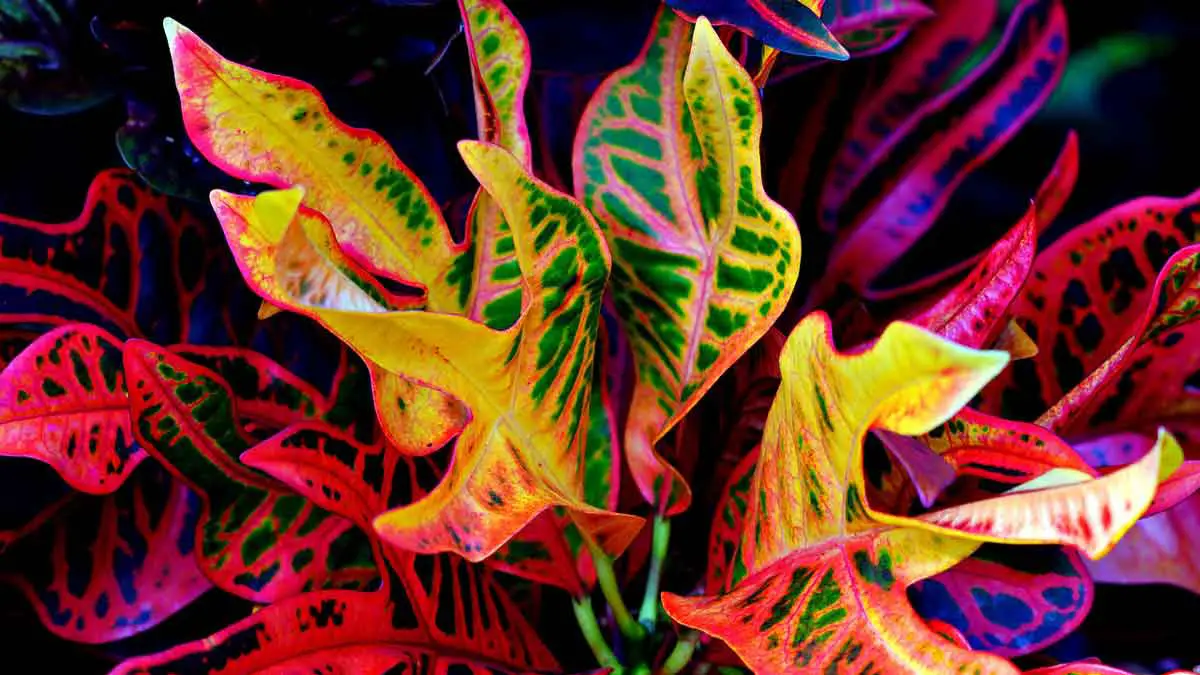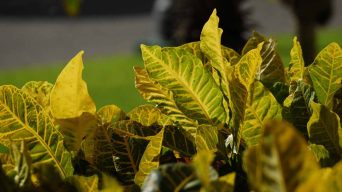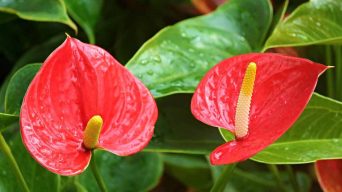Croton plants are one of the most popular houseplants, and for a good reason.
They’re beautiful, low-maintenance, and easy to care for.
However, even the most experienced gardener can run into problems from time to time.
If your croton plant is dying, don’t despair!
There are several things you can do to save it.
To save your croton plant, you need first to identify the problem.
Why Is My Croton Plant Dying?
There are several reasons why your croton plant may be dying.
Here are some of the most common causes:
1. Too Much Water
One of the most common reasons a Croton plant dies is too much water.
Crotons are native to tropical climates and prefer to be constantly moist.
However, they will not tolerate sitting in water.
If the roots of your indoor plant are constantly wet, they will not be able to get the oxygen they need to survive and will eventually die.
How To Tell if You’re Overwatering Your Croton Plant
There are a few tell signs that you’re overwatering your Croton plant:
- The leaves of the Croton plant are drooping
- The leaves are yellow or brown
- The stems are soft or mushy
- The leaves have brown or black edges or spots
- The roots are soft or mushy
If you notice any of these signs, you must take action immediately.
How To Save an Overwatered Croton Plant
If you think you may have overwatered your Croton plant, the first thing you need to do is stop watering it.
Allow the soil to dry out completely before watering again.
You also need to check the drainage of your pot.
Ensure it is draining properly and the roots are not sitting in water.
If the roots are soggy, you may need to repot your plant in fresh, dry soil.
2. Not Enough Water
While too much water can kill your Croton plant, not enough water can also be detrimental.
Crotons need to be constantly moist to thrive.
If the potting soil is allowed to dry out for too long, the plant leaves will begin to wilt and turn brown.
The plant may also drop its leaves.
How To Tell if You’re Underwatering Your Croton Plant
There are a few signs that you may be underwatering your Croton plant:
- The leaves of the plant are wilting or drooping
- The leaves are crunchy and dry
- The leaves are curling
- The growth is stunted
If you notice any of these signs, you must take action immediately.
How To Save an Underwatered Croton Plant
If you think your plant is not getting enough water, you first need to water it.
Give your plant a good soaking and ensure the water reaches the roots.
Once you’ve watered your plant, it’s important to continue watering it regularly.
Croton plants need to be watered every few days to stay healthy.
3. Lack of Humidity
Crotons are native to tropical climates and prefer high humidity.
If the air in your home is too dry, the leaves will lose moisture and eventually turn brown and crispy.
The plant may also drop its leaves.
How To Tell if Your Croton Plant Needs More Humidity
There are a few signs that your Croton plant is not getting enough humidity:
- The leaves are wilting or drooping
- The leaves are brown or crispy
- The leaves are curling
- The plant is dropping its leaves
If you notice any of these signs, you must take action immediately.
How To Increase the Humidity for Your Croton Plant
There are a few things you can do to increase the humidity of your Croton plant:
- Group your plants: Plants release moisture into the air as they transpire. By grouping your plants, you will create a more humid environment.
- Use a pebble tray: Fill a tray with pebbles and water. Place your plant on top of the pebbles. As the water evaporates, it will increase the humidity around the plant.
- Use a humidifier: A humidifier will add moisture to the air and create a more humid environment for your plants.
4. Lack of Light
Crotons need bright indirect light to thrive.
When the plant doesn’t get enough light, it cannot produce the food it needs to survive.
This will cause the plant to become stunted and weak.
The leaves may also start to turn yellow or brown.
How To Tell if Your Croton Plant Needs More Light
There are a few signs that your Croton plant is not getting enough light:
- The leaves are pale or yellow
- The leaves are small or stunted
- The plant is not growing
- The plant leans toward the light
If you notice any of these signs, you must take action immediately.
How To Increase the Light for Your Croton Plant
You can do a few things to increase the light for your Croton plant.
You need to move your plant to a brighter location.
An east- or west-facing window is ideal. This will give your plant the bright indirect light it needs to thrive.
Croton plants need at least four hours of light per day.
If you cannot move your plant to a sunnier location, you may need to supplement the light with grow lights.
Place your plant under a grow light for at least four hours daily. This will give your plant the light it needs to stay healthy.
5. Too Much Sunlight
While crotons need bright light to thrive, they can’t handle too much direct sunlight.
The leaves of the plant will start to fade or burn if they are in direct sun for too long.
The leaves may also become crispy and dry.
If your plant is getting too much sunlight, it’s essential to take action immediately.
How To Tell if Your Croton Plant is Getting Too Much Sunlight
There are a few signs that your Croton plant is getting too much sunlight:
- The leaves are faded or bleached
- The leaves are crispy or dry
- The plant is wilting
- The leaves have brown patches
If you notice any of these signs, you must take action immediately.
How To Reduce the Sunlight for Your Croton Plant
There are a few things you can do to reduce the sunlight for your Croton plant:
- Move your plant to a shadier location: If your plant is in direct sunlight, move it to a shadier spot. An east- or west-facing window is ideal.
- Provide shade with a sheer curtain: If you can’t move your plant, you can provide shade by hanging a sheer curtain over the window.
- Place your plant in a terrarium: A terrarium will protect it from the sun and provide the humidity it needs to thrive.
6. Temperature Stress
Crotons are tropical plants, and they need warm temperatures to thrive.
The ideal temperature for a Croton plant is between 65 and 85 degrees Fahrenheit.
If the temperature gets too cold, the plant leaves will start to turn brown and drop off.
The plant may also become stunted and stop growing.
How To Tell if the Temperature Stresses Your Croton Plant
There are a few signs that the temperature stresses your Croton plant:
- The leaves are brown or dropping off
- The plant is wilting
- The leaves are falling
- The plant is stunted
If you notice any of these signs, you must take action immediately.
How To Increase the Temperature for Your Croton Plant
There are a few things you can do to increase the temperature of your Croton plant:
- Move your plant to a warmer location: If the temperature is too cold, move your plant to a warmer place.
- Use a heat mat: Place a heat mat under your plant to increase the temperature around it.
- Use a grow light: A grow light will not only provide light but also generate heat, which will help keep your plant warm.
7. Nutrient Deficiency
Crotons need nutrients to thrive. If they don’t get enough nutrients, the plant leaves will start to turn yellow. The plant may also become stunted and stop growing.
A nutrient deficiency can be caused by several things, including poor soil, insufficient fertilization, or too much water.
How To Tell if Your Croton Plant Has a Nutrient Deficiency
There are a few signs that your Croton plant has a nutrient deficiency:
- The leaves are yellow
- The plant is stunted
- The leaves are small
- The plant is not growing
If you notice any of these signs, you must take action immediately.
How To Fix a Nutrient Deficiency in Your Croton Plant
There are a few things you can do to fix a nutrient deficiency in your Croton plant:
- Fertilize your plant: Use a fertilizer high in nitrogen and phosphorus.
- Add compost to the soil: Compost will add nutrients to the soil and help your plant to grow.
- Repot your plant: If the potting soil is poor, repot your plant in fresh, nutrient-rich soil.
8. Rootbound
Crotons need room to grow. If the plant’s roots become constricted, it can cause several problems.
A rootbound plant is not able to take up nutrients and water efficiently. This can cause the Croton leaves to turn yellow and the plant to become stunted.
How To Tell if Your Croton Plant is Rootbound
There are a few signs that your Croton plant is rootbound:
- The roots are coming out of the drainage holes
- The roots are wrapped around the pot
- The plant is wilting
- The leaves are yellow
- The leaves are curling
- The plant is stunted
If you notice any of these signs, you must take action immediately.
How To Fix a Rootbound Croton Plant
There are a few things you can do to fix a rootbound Croton plant:
- Repot your plant: Choose a pot 2-3 inches wider than the current pot.
- Prune the roots: Use a sharp knife to cut away any roots wrapped around the pot.
- Water your plant: Water your plant thoroughly and allow the water to drain completely.
9. Overfertilization
Crotons need nutrients to thrive, but too much fertilizer can be just as harmful as not enough.
If you fertilize your Croton plant too often or with too high of a concentration, the plant’s roots can burn.
This will cause the plant to be unable to take up nutrients and water.
The leaves of the plant will start to turn yellow, and the plant may become stunted.
How To Tell if Your Croton Plant is Overfertilized
There are a few signs that your Croton plant is overfertilized:
- The leaves are yellow
- The leaves are brown
- The leaves are falling off
- The plant is wilting
- The plant is stunted
- The roots are black
If you notice any of these signs, you must take action immediately.
How To Fix an Overfertilized Croton Plant
There are a few things you can do to fix an overfertilized Croton plant:
- Flush the soil: Water your plant thoroughly and allow the water to drain completely. This will help to flush the fertilizer out of the soil.
- Repot your plant: If the soil is heavily fertilized, repot your plant in fresh, clean soil.
- Don’t fertilize your plant: If you’ve recently fertilized your plant, wait a few weeks before fertilizing again.
10. Pest Infestation
Crotons are susceptible to several pests, including aphids, mealybugs, and scale.
Aphids are small, green insects that feed on the sap of plants.
Mealybugs are white, fuzzy insects that feed on the leaves and stems of plants.
Scale insects are small, brown insects that suck the sap out of plants.
A pest infestation can cause the leaves of your Croton plant to turn yellow and eventually drop off. The plant may also become stunted.
How To Tell if Your Croton Plant Has Pests
There are a few signs that your Croton plant has pests:
- The leaves are yellow
- The leaves are covered in a sticky substance
- The leaves are covered in white fuzzy insects
- The leaves are covered in small, brown insects
- The leaves have holes
- The plant is wilting or drooping
If you notice any of these signs, you must take action immediately.
How To Get Rid of Pests on Your Croton Plant
There are a few things you can do to get rid of pests on your Croton plant:
- Isolate the plant: If you have other plants, isolating the infested plant is essential to prevent the pests from spreading.
- Remove the pests by hand: Use a cotton swab or cotton ball dipped in rubbing alcohol to remove the pests from the plant.
- Spray the plant with insecticidal soap: Mix water and insecticidal soap and spray the plant, being sure to coat the undersides of the leaves.
- Apply neem oil: Neem oil is a natural pesticide that can effectively control pests.
11. Disease
Crotons are susceptible to different types of diseases, including root rot, leaf spot, and powdery mildew.
Root rot is a fungal disease that causes plant roots to rot.
Leaf spot is a fungal disease that causes spots on the plant’s leaves.
Powdery mildew is a fungal disease that causes a white, powdery growth on the plant’s leaves.
Diseases can cause the leaves of your Croton plant to turn yellow and eventually drop off. The plant may also become stunted.
How To Tell if Your Croton Plant Has a Disease
There are a few signs that your Croton plant has a disease:
- The leaves are yellow
- The leaves have black or brown spots
- The leaves are covered in a white, powdery substance
- The plant is wilting or drooping
If you notice any of these signs, you must take action immediately.
How To Treat a Diseased Croton Plant
There are a few things you can do to treat a diseased Croton plant:
- Isolate the plant: If you have other plants, isolating the infested plant is essential to prevent the disease from spreading.
- Remove the affected leaves: If the plant has a few diseased leaves, remove them from the plant.
- Apply a fungicide: If the plant is heavily diseased, apply a fungicide according to the label directions.
- Repot the plant: If it is heavily diseased, repot it in fresh, clean soil.
- Destroy the plant: If it is too far gone, it’s best to destroy it to prevent the disease from spreading.
Final Thoughts
With proper care, croton plants can be relatively easy to care for.
However, several things can go wrong.
If you notice that your plant is dying, take action immediately to save it.
By quickly diagnosing the problem and taking the appropriate actions, you may be able to save your plant.







